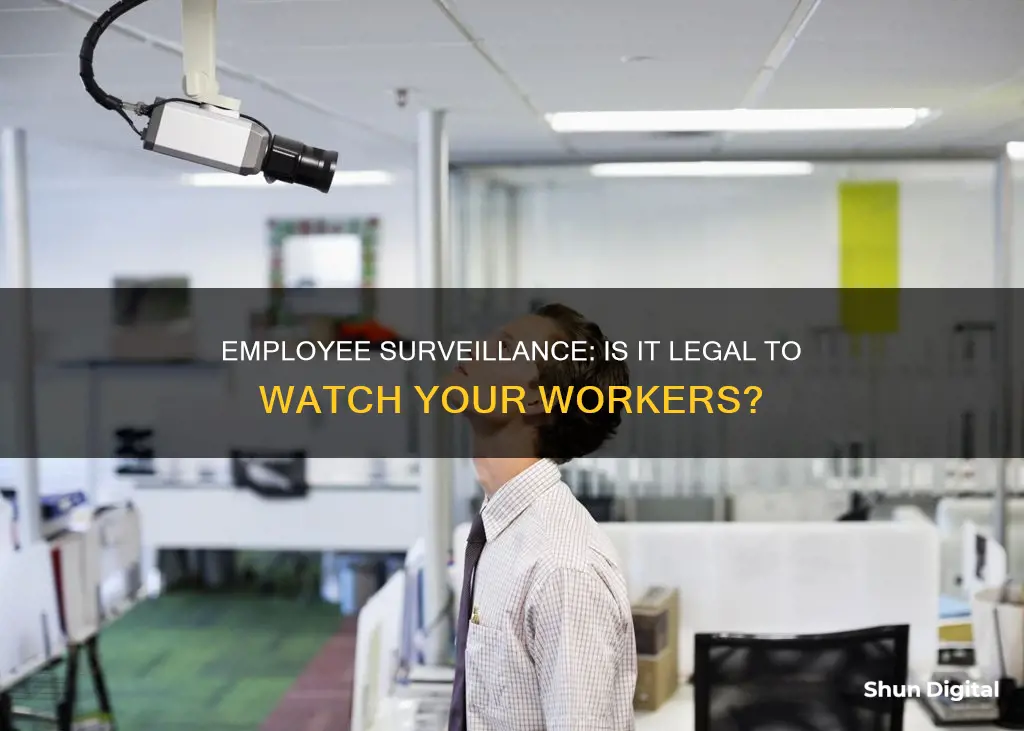
The use of surveillance cameras in the workplace is a highly debated topic, with privacy laws varying by state. While there is no federal law that prohibits the practice, several states have laws that explicitly address it. For example, California, Connecticut, Delaware, and New York prohibit video or audio surveillance in certain areas, such as restrooms or break rooms. In California, employers must disclose all video monitoring to employees and obtain their consent, while federal law does not require this. Employers must also have a legitimate business reason for using video cameras, such as monitoring security or preventing theft. However, employees' reasonable expectations of privacy must be considered, and surveillance in private areas such as restrooms or locker rooms is generally not allowed.
| Characteristics | Values |
|---|---|
| Legality | Generally legal, but depends on state law and employee consent |
| Purpose | Security, theft prevention, monitoring employee activity |
| Location | Public areas, not private spaces (e.g. restrooms, locker rooms) |
| Notification | Employees must be informed of the presence of cameras |
| Consent | Consent required in some states and for audio recordings |
| Legitimate Business Need | Must have a valid reason, e.g. security, theft prevention |
| Union Activity | Employers cannot record union meetings or activities |
What You'll Learn

Surveillance in public areas
The presence of surveillance cameras in public spaces is a contentious issue, with some people feeling more secure with the technology, while others feel their privacy is being invaded.
The Pros
Those in favour of public surveillance cameras argue that they:
- Deter crime and reduce crime rates
- Help catch criminals
- Improve public safety
- Provide evidence and gather clues
- Bring convenience to everyday life
The Cons
Those against public surveillance cameras argue that they:
- Are an invasion of privacy
- Are expensive
- Are open to abuse and voyeurism
- Are not proven to be effective
The Law
In most countries, there are few laws regulating the use of surveillance cameras in public spaces. In the United States, for example, there are no federal laws prohibiting their use in public spaces, and only a handful of states have passed legislation to regulate their usage.
However, it is generally illegal to place hidden cameras in areas where individuals have a reasonable expectation of privacy, such as bathrooms and changing rooms.
In the state of California, it is a crime to install a surveillance mirror in a restroom, shower, fitting room, or locker room. In Connecticut, employers may not operate surveillance equipment in areas designed for employee rest or comfort, such as restrooms, locker rooms, or employee lounges.
Best Practices
When implementing public surveillance, it is important to consider the following:
- Only place cameras where they are needed most
- Monitor them from a central location
- Ensure they are used to keep people and property safer, and to provide video evidence when required
- Be transparent about their usage
Paranormal Caught on Camera: Best Viewing Platforms
You may want to see also

Surveillance in private areas
Legality of Surveillance in Private Areas
The legality of workplace surveillance depends on state law and the specific images being captured. In general, employers are permitted to conduct video surveillance in "public" areas as long as employees are notified about it. However, surveillance in private areas, such as restrooms, locker rooms, or changing rooms, is typically prohibited by state laws and may violate employees' reasonable expectation of privacy.
For example, in California, it is illegal to install a surveillance mirror in private areas, and in Connecticut, employers may not operate surveillance equipment in areas designated for employee rest or comfort, such as restrooms and locker rooms.
Best Practices for Employers
To avoid legal issues, employers should follow these practices:
- Use only visible cameras or inform employees in writing about the use of hidden cameras.
- Obtain written consent from employees for video surveillance.
- Do not conduct video surveillance in areas where employees have a reasonable expectation of privacy, such as bathrooms, locker rooms, dressing rooms, and employee lounges.
- Comply with any provisions in collective bargaining agreements regarding video surveillance if the workplace is unionized.
- Do not use video surveillance in connection with union activities or other "concerted activities" related to employment terms or conditions.
- Ensure that the selection of employees for video surveillance is not discriminatory or retaliatory.
- Understand and comply with state or local laws governing video surveillance.
- Treat information obtained through video surveillance as confidential and limit access to authorised personnel.
Employee Perspective
Employees may have concerns about the impact of surveillance on their privacy. They may feel uncomfortable being monitored, which could negatively affect their relationship with the employer.
Legal Recourse for Employees
If employees feel their privacy rights have been violated, they may be able to take legal action. In California, for instance, employees can recover emotional damages in court if they can prove that their privacy rights were infringed upon by the employer's monitoring activities.
In conclusion, while workplace surveillance can serve legitimate business purposes, it is essential to respect employees' privacy rights and comply with relevant state and local laws to avoid legal repercussions and maintain a positive relationship with employees.
Candid Camera: Best Places to Watch the Show
You may want to see also

Consent and notification
The use of video surveillance in the workplace is a common practice for many businesses, especially those dealing with cash or inventory, such as financial institutions and retail stores. Companies monitor their employees for various reasons, including preventing theft, harassment, and vandalism. While video surveillance is generally permissible, there are important considerations regarding consent and notification to ensure the protection of employees' privacy rights.
Consent
In most cases, employers must obtain consent from employees before implementing video surveillance. This can be done by including a surveillance policy in the employee handbook, requiring employees to sign a form releasing the company from liability, and obtaining written confirmation of their understanding and consent to be recorded. Some states, such as New Hampshire, Maine, Kansas, South Dakota, and Delaware, require explicit consent for the use of hidden cameras.
Notification
Employers are typically required to notify employees about the use of video surveillance. This includes disclosing the presence of security cameras and their locations. It is recommended to provide this notification in writing, such as in an employee handbook, and to make the cameras visible and easily noticeable to employees and visitors. While signage may not be legally required in all cases, it is often advisable to include it as an additional measure.
State-Specific Laws
It is important to note that laws regarding workplace privacy vary from state to state. For example, in California, it is illegal to install a one-way mirror in restrooms or locker rooms, while in Connecticut, employers are prohibited from using video surveillance in areas designated for employee rest and comfort. Therefore, it is crucial for organizations to review their local privacy laws to ensure compliance.
In summary, while video surveillance in the workplace can be a valuable tool for businesses, it is essential to obtain consent, provide proper notification, and adhere to state-specific laws to respect employees' privacy rights.
Monster High: Frights, Camera, Action! Streaming Options Revealed
You may want to see also

Legitimate business reasons
There are several legitimate reasons for a business to monitor its employees on CCTV or video cameras. Here are some key examples:
Security and Protection:
- Staff Security: One of the primary reasons for deploying CCTV cameras in the workplace is to ensure the security and protection of staff. Cameras can help protect employees against assault, harassment, and other security threats. This is especially important in environments where staff may be at risk, such as in busy industrial floors or reception areas.
- Deterring Vandalism and Theft: CCTV cameras act as an effective deterrent against vandalism and property theft. They can also aid police investigations and provide valuable evidence in court if an incident occurs.
Workplace Efficiency and Optimisation:
- Resource Utilisation: CCTV cameras can provide important insights into how company resources are used. For example, they can help identify overcrowded areas or inefficient logistics operations, enabling management to optimise day-to-day operations and improve overall workplace efficiency.
- Health and Safety Compliance: Cameras can also be used to enforce health and safety policies and ensure compliance with relevant regulations. Given the complex nature of these policies, cameras can provide immediate feedback on any breaches, helping to ensure that momentary lapses do not become the norm.
Preventing Internal Theft and Fraud:
This is a common reason for businesses to install cameras, especially in retail establishments. Cameras can help deter and detect internal theft, ensuring that employees are not stealing items or engaging in fraudulent activities.
Recording Employee Accidents and Incidents:
Cameras can capture incidents and accidents that occur in the workplace. This can be important for insurance purposes, legal liability, and ensuring the safety of employees.
Lowering Insurance Costs and Premiums:
The use of video surveillance can often lead to lower insurance costs for businesses. Insurance providers may offer reduced premiums if a company implements effective security measures, including CCTV systems.
It is important to note that while these reasons are generally considered legitimate, businesses must still comply with relevant privacy and data protection laws. This includes obtaining employee consent, notifying employees about the monitoring, and ensuring that the surveillance does not infringe on employees' reasonable expectations of privacy.
Apple Watch Ultra: Camera Expectations and Realities
You may want to see also

Invasion of privacy
In general, employers are permitted to use video surveillance in the workplace as long as they have a legitimate business reason for doing so, such as preventing theft or monitoring employee interactions with the public. Most states allow video surveillance in "public" areas of the workplace, as long as employees are notified about it. However, there are certain areas where employees have a heightened expectation of privacy, such as restrooms, locker rooms, and changing areas. Surveillance in these areas is typically prohibited without a court order.
In addition to location-based restrictions, some state laws also prohibit the use of certain types of surveillance equipment, such as surveillance mirrors in restrooms or locker rooms. Federal law also prohibits the recording of certain oral communications under the Federal Wiretap Law, which is why surveillance cameras typically do not have audio.
To prove an invasion of privacy case based on workplace surveillance, an employee must demonstrate that their expectation of privacy was reasonable based on the employer's policies, past practices, and common sense. For example, if an employer has not warned workers that certain areas may be monitored, an employee may have a high expectation of privacy in those areas.
It is important to note that invasion of privacy in the workplace can also extend beyond video surveillance. For instance, installing hidden cameras, monitoring phone calls, or tracking employees outside of the workplace without their consent can also be considered an invasion of privacy.
If an employee believes their privacy rights have been violated, they may have grounds to sue their employer. However, it is important to consult with an employment law attorney to understand the specific laws and protections in their state.
Paranoia or Reality: FBI Surveillance via My Camera?
You may want to see also
Frequently asked questions
There is no federal law that prohibits the use of surveillance cameras in the workplace. However, there are important limits on where employers can install cameras and the purposes for which they can use them. In some cases, an employee's expectation of privacy outweighs an employer's interest in surveillance.
Employers must have a legitimate business reason for using video cameras to record employees. Surveillance is generally permitted in public areas, and employers must disclose all video monitoring to employees. Surveillance is prohibited in areas where there is a reasonable expectation of privacy, such as restrooms, locker rooms, and break rooms.
Even without explicit state laws, courts typically weigh two factors to determine if the use of video surveillance is justified: employees' reasonable expectation of privacy and the employer's legitimate business purpose.







